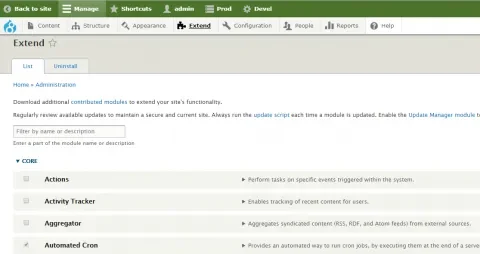English version was created automatically using Drupal module auto_node_translate and free DeepL translator.
Drupal 8 - modules, themes, distributions ...
published on 2019-02-13
Drupal itself is a basic platform to which additional functionality can be added through various modules. The display of all this is handled by the theme. And all this can be packaged together in so-called Drupal distributions.
Introduction
Thanks to this brief introduction to Drupal, we have a basic idea of what its strengths are and when it makes sense to start thinking about Drupal. Now we'll take a closer look at the cornerstones of any site built on Drupal.
Drupal core = necessary foundation
https://www.drupal.org/docs/8/core/basic-structure-of-drupal-8
Drupal core is the foundation that provides the basic functionality. Think of it as a basic board for building Lego (Lego is a common simile used for Drupal).
Drupal core modules = a basic set of modules
https://www.drupal.org/docs/8/core/modules
The core itself is the bare basics that need to be extended with additional functionality. This is done by using a core set of modules, called Code modules. Most of these modules are enabled by default installation, but turning them off/on or installing without them is preferred by most more experienced users who already have experience and know what they want.
For example, why have a multilingual module enabled for a monolingual site. It's like getting a Lego box with blocks, in one case already assembled, in the other case the blocks are extra.

Drupal contributed modules = extension modules
https://www.drupal.org/docs/8/modules/, https://www.drupal.org/project/project_module/index?project-status=full…
I'll start by comparing it to legos - modules are like expansion bags with wheels, movers ... Something for everyone, depending on what they're building. There are tons of possible combinations, sometimes it's hard to choose the right combination, especially when different modules do the same/similar things.
Drupal core themes
https://www.drupal.org/docs/8/core/themes
There are several core themes in Drupal, both for the frontend and backend (administration). The classic Drupal theme for the frontend is Bartik, and for the backend is Seven. Bartik will probably only serve as a test theme, the admin theme Seven is fine to work with.
Drupal contributed themes = extensible themes
https://www.drupal.org/docs/8/themes, https://www.drupal.org/project/project_theme
Like contrib modules, there are community-created themes. Some better, some worse, but you can find a few usable ones. You'll probably pick a few to suit your needs anyway, or create some of your own. You can also definitely recommend trying to create a subtheme of an existing design.
Attention: themes mean JavaScript, among other things, so beware of cheat codes for Bitcoin mining, etc. Especially themes downloaded from various unofficial portals can cause mischief.
Drupal distributions = installation including already prepared modules, configurations ...
https://www.drupal.org/docs/8/distributions
If you add your own selected modules, various additional libraries, their configuration and settings to the base Drupal, you have actually a custom Drupal installation, i.e. a distribution.
Often mentioned distributions include
- Open Social - Open Social is a Drupal 8 distribution for building social communities, intranets, portals and any other social project you can dream of.
- Thunder - A distribution for professional publishing by Hubert Burda Media
- deGov - deGov is the first Drupal 8 distribution focusing on the needs of (German) governmental organisations.
You can already see from the descriptions that these are not amateur projects, but large and solid projects.
By way of conclusion
Before we get into anything more complex, we need to go over the basics. So Drupal core and its basic modules.